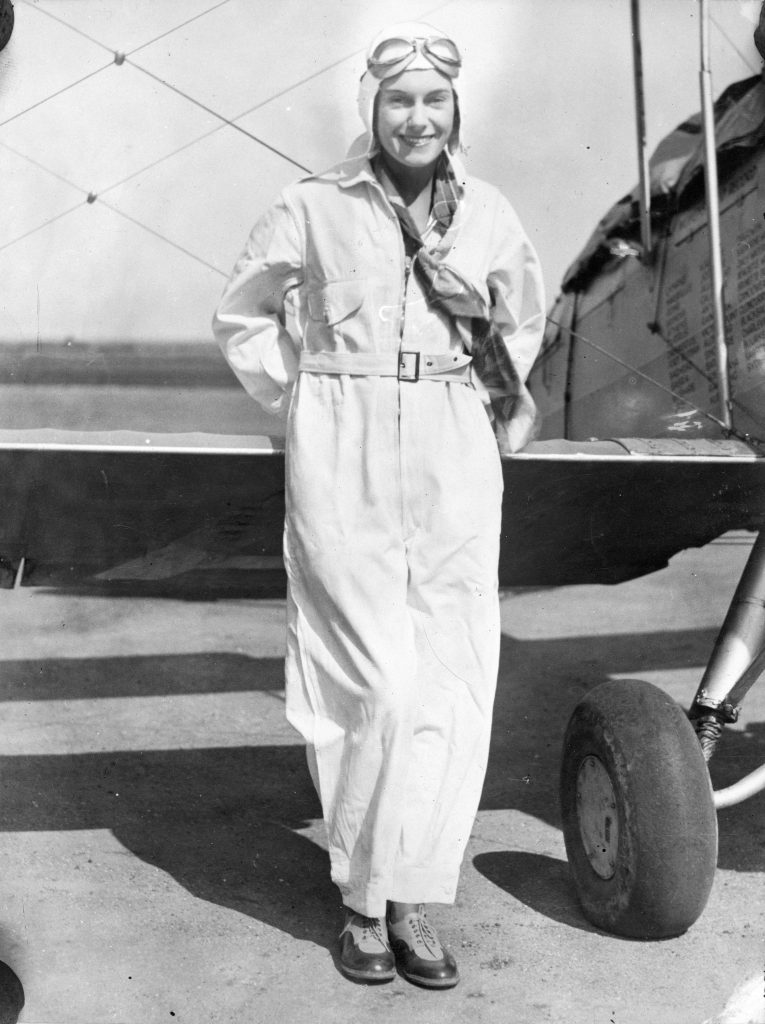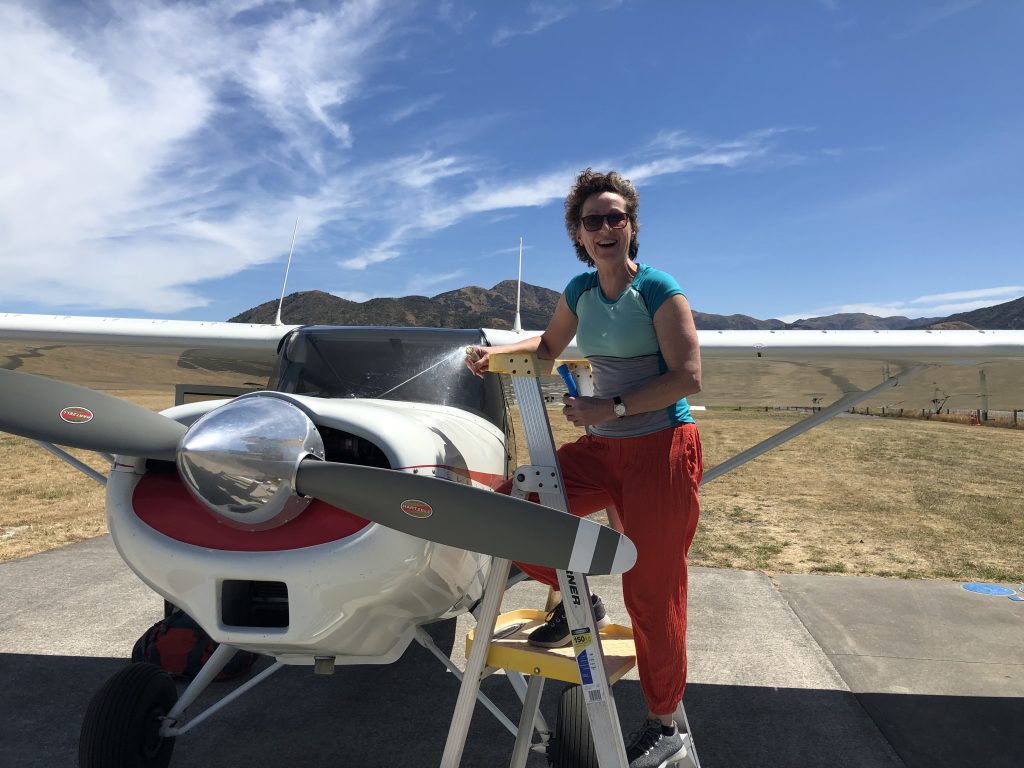“Any day now / That joke will turn sour / And she’ll say a sweet goodbye / She’ll pack up her things / Strap on her wings and fly” – Aviatrix, The Lucksmiths
IT’S HARD TO PINPOINT, BUT THE HISTORY OF WOMEN IN AVIATION IN AOTEAROA MAY HAVE STARTED WITH A BALLOON, A WET SOUTHLAND PADDOCK, AND MILLIE VIOLA, AERONAUT, DAREDEVIL AND, THEY SAID, A BIT OF A LOOKER. IT WAS 1892, AND THE THOUSANDS WHO HAD PAID THEIR ONE SHILLING (CHILDREN HALF PRICE) WERE AGOG AT THE THOUGHT OF WHAT THEY WERE ABOUT TO SEE: A HOT AIR BALLOON, A TRAPEZE ACT PERFORMED SUSPENDED FROM SAID BALLOON, AND A PARACHUTE DESCENT.
Millie, an American actress turned stuntwoman, was up for it, but the southern winter with its “boisterous weather” had other plans. It was wet underfoot and too cold outside, and the kerosene burner couldn’t inflate the balloon. After a delay of a few days, the balloon finally rose, but tipped on its side when Millie leapt onto the trapeze. During another attempt a few days later, a wind gust pushed the flame into the Irish linen fabric.
Finally, on August 13, 1892, thanks to a team of locals, their sewing machines and some calico, Millie was finally raised several hundred feet aloft–though she estimated it at 1000ft–to swing on her trapeze while calling out to the crowd below. The parachute descent would have to wait for another day.
–
Pilot Sue Kronfeld was 10 years old when she first got the itch. “I was going to Fiji with my parents. I jumped on that DC-10 and I thought ‘How does this hunk of metal get into the air?’ It activated me.” Seven years later, a trial flight with an instructor in a dual control Cessna sealed it. “I got on that plane and thought, ‘Now this is me. How the hell does this work?’” By the age of 19, she had flown her first solo.

Today, Sue is an instructor in both mountain flying and aerobatics, and the CEO of Wānaka’s Top Flights, which runs scenic tours, training and vintage flying experiences. (Ever fancied popping on a leather helmet, goggles and silk scarf for a spot of barnstorming in a Tiger Moth? Sue will take you.) In more than 30 years as a pilot, she has amassed 7700 hours of active flying, much of it piloting amongst the mountains of the Southern Alps, making her living in General Aviation (GA), rather than the more common “airline pilot” career path.
“remember there is no place for mad impulses or wild hysterics”
Sue headed to Wānaka in 1988, commercial license in hand, after a stint training at the flight school in Paraparaumu. “I wanted to go up in the air and explore. So I turned up to Aspiring Air on the bike and said ‘Hi, I’m a commercial pilot, give me a job.’ I was told by management to go back to where I came from, get another 600 hours, and they’d give me one.” She returned to Paraparaumu, clocked up the requisite hours, and Aspiring Air hired her as a line pilot.
More than three decades on, she loves it still. “The thing with the aviation side of it is discovery. I always find out different stuff. I’m hands-on flying, so all my flying has some scenario that has to be covered.”
The former president of the New Zealand Association of Women in Aviation (NZAWA), Sue is also a vocal advocate for female pilots. Flying is a dude-heavy industry. Air New Zealand’s first female air captain, Auckland pilot Jan Everest, wasn’t appointed until 1986, while Angie Dickinson became the first woman to serve as a pilot in the Royal New Zealand Air Force in 1988.
It’s likely Millie the aeronaut would be unimpressed with the 100-year gap between her exploits and these appointments, and with the state of things today. On average, only of 5% of commercial pilots in the world are female; at Air New Zealand, it’s a slightly better 7.4%.
Swinging from flaming hot air balloons aside, early views on the unsuitability of the female temperament and physicality for flight took a while to change. The attitudes held weren’t always limited to men. Shirley Lainé’s excellent book Silver Wings chronicles the endeavours of female aviators here and abroad. She describes how Aroha Clifford from Christchurch was our country’s first club-trained woman to gain a licence, in 1929, and the second licensed woman pilot in New Zealand after Gladys Sandford (1925). Aroha was the first to clock up 40 hours solo and receive her passenger endorsement, and she racked up an impressive number of cross-country flights.
She also had some cautionary words for her gender: “Women generally speaking are not good at estimating the distance and this to my mind is a serious handicap for flying, but remember there is no place for mad impulses or wild hysterics.”

The NZAWA was founded in 1959 by Rhona Fraser MNZM, the first woman to gain her private pilot’s licence after World War II, and Aotearoa’s greatest pilot, Jean Batten, was Patroness of the association until her death in 1982.
Jean’s efforts to build a career without her father’s financial support or approval, and without the paid flying opportunities afforded to men, was a grind of dingy bedsits and pennypinching, and, later, dramatic crashes. These included multiple sandstorm incidents, as well as running out of fuel in a horrendous windstorm over the Mediterranean and gliding her Gipsy Moth to a safe (or safe-ish) landing in Rome through a maze of buildings, trees and power lines. The Moth was munted, but she was fine, and went on to set records including becoming the first woman to fly return from England to Australia and the first pilot to fly from England to New Zealand. She was celebrated (‘JEANIUS’, one headline read), but hounded too, called a gold-digger and selfish for eschewing the proper trappings of feminine life: marriage, children, domesticity. She died alone in Majorca, and was buried in an unmarked grave.
The NZAWA celebrates feminine life differently, holding rallies annually over Queen’s Birthday Weekend at different locations, alternating between the North and South Islands. As Sue explains, “When us aviatrix congregate, we can relax in our interest of flying. We can talk about carburettors and aspirated motors and types of aircraft with some like-minded women and understand each other.”
Sue is also part of a strong local community of pilots. Davida Mead of Dingleburn Station in Hāwea attained her commercial license in 1985, and spent 17 years flying passengers around Mt Aspiring National Park and into Milford Sound. She also flew a helicopter around the mountainous hillsides of the farm running chores like dropping off musterers. Queenstown-based Louisa ‘Choppy’ Patterson has been buzzing around the hills and waterways since 1986, and now runs Over The Top Helicopters. Megan George is the chief pilot for Glenorchy Air, which runs scenic flights and glacier landings, while Te Anau’s Kylie Krippner takes passengers for flights in the only seaplane in Fiordland. All have decades of experience piloting in and around the Southern Alps.
Mountain flying is serious, but it’s rewarding too. As an instructor, Sue particularly enjoys helping people overcome their fear of piloting in alpine terrain. “People often approach me for a mountain flying course because they’ve got to meet the prerequisite for their private pilot or commercial licence. But I get a percentage of people who are already pilots, and for some reason may have had a fright, or they were in turbulence. They just want to know how to approach weather and read it, and where to find energy of the air moving upwards in a comfortable environment.
“Flying towards the mountains, the instinct for everyone is to pull the stick back. You gotta keep flying that plane and overcome the illusion of mountainous terrain, and that’s really hard.”
Sue says flying as commercial operator in the vicinity of huge mountains requires discipline and planning, but also attention to the comfort of clients, which is a good skills exercise. Flying with passengers, she explains, has “taught me to fly to energy in the conditions to get a smoother ride.”
When asked what ultimately drew her to flying, Sue answers like so many people who have ever been attracted to flight: “the essence of that question is freedom.” Jean Batten once said something similar. “In flying I found the two things that meant everything to me: the intoxicating drug of speed and the freedom to roam the earth; I knew I was destined to be a wanderer.”
The New Zealand Association of Women in Aviation aims to foster networks, unity and sorority among women interested in aviation. Membership ranges from ages 2 to 92, PPL students to ATPL captains, from balloonists to glider pilots to engineers, meteorologists, air traffic controllers and enthusiasts. Find out more at: nzawa.org.nz
TIM BREWSTER

